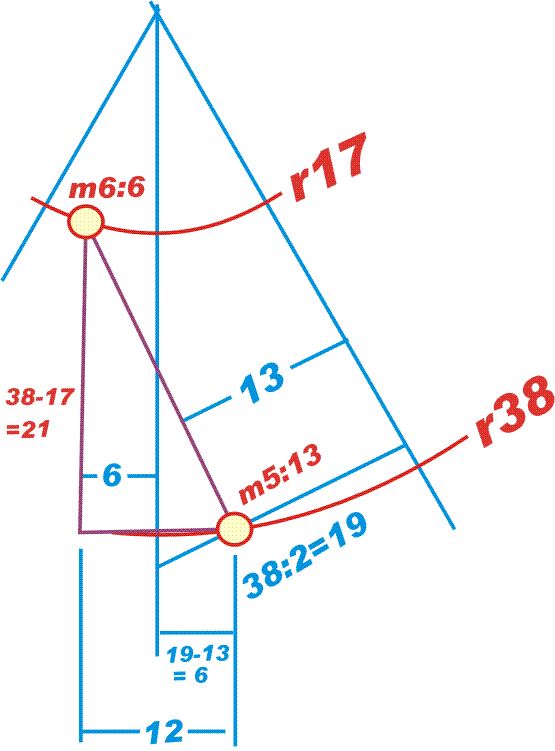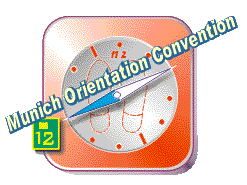Volksnav© in Neustrelitz
Neustrelitz has the option to be world's first city that has realized an international orientation standard, an idea from a Munichian inventor to simplify and harmonize worldwide all orientation means: signage, cartography, navigation devices and verbal expressions.
Within this city, it is (will be) possible to find any target with easy brain work, that means
| - without maps, | - without names, |
| - without illogical numbers | - without arrows |
| - without floor marks | - without square grids |
| - without colors | - without compass or other navigation devices |
Buildings, crossings, stop points, bridges etc. have logical addresses like
Landestheater StatusQuo© Neustrelitz m8 r6
Kloster Wanzka m2:12 r120
Burg Fürstenberg m5:50 r203
which are easy to
understand if you associate the city with a clock as follows:
An outstanding point as e. g. the Markt was (will be) defined as a pole m0. Around this pole, the horizon is divided in 12 "horizon hours" m1 to m12 , whereas m12 points to north. This divides the city as a cake in 12 imaginary sectors. As an example, the sector m7 was marked. |
 |
 |
The sectors are divided in horizon minutes.
These are not angles but DISTANCES to the horizon hour, in steps
of approx one "block of houses" or 100 meters.
Example m3:1 ( read "emm 3 point 1" or "emm three 1" ). This is a line situated in a distance of 1 x 100m from the horizon hour m3, which points to sunrise The convention for horizon minutes is very simple: the greater, the later. |
Considering the distance to m0 as r = radius also in steps of blocks of houses, logical position codes for targets, buildings, crossings etc. come into existence, e. g. as shown on the picture: crossing StatusQuo© m7:2 r7 StausQuo means "where you are". In simple words: "r" is a numbering starting FROM m0, "m" is a north-direction-based numbering AROUND m0 and this simple methode covers a gigantic market gap: l o g i c a l and easy understandable p o s i t i o n codes. |
 |
Natural Cartography©:
a map with such a polar grid has innovative characteritics, see www.volksnav.com/map . Please be aware about the fact that if the target isn't on map, with the help of the logical position code it's possible to imagine where it is situated !! Example: crossing Kalkhorstweg / Schlangenallee StatusQuo© NSTZ m5:11 r37
Interesting details:
- the search grid contains quadrangules similar to the conventional ones. The picture above shows a black quadrangule with the dimensions 100m x 100m. The bended sides let know in which direction the urban pole is situated, even if the centre isn't on map.
- the width of the sector is half the radius !! Example: m7:5 r10, m7:10 r20 etc..
- the middle of the sector is radius/4. Example: m7:5 r20
.
Signage: StatusQuo© addresses will be integrated within the existing signage, see www.volksnav.com/lollipop, or be indicated on so-called Orientators©, the signage of the future. Vertical Pointing©: additional to the position information, a round symbol called center or pole pointer will be placed on their periphery to allow to detect the direction m0 according to the following conventions:
etc. Acc. to the same convention, a square symbol points to north = m12. The picture reveils: m12 is behind, the pole is right hand |

Orientator© |
Navigation / VolksNav©:
The local navigation with the help of such codes is called VolksNav©. As proceeded today with house numbers, VolksNav© is nothing else than the major/minor comparison between "r" and "m" values:
Simply proceed according to 1 -2 -3 :
| 1 -
Positioning
|
Turn your body until m0 will be BEHIND. In this position,
etc. Beginners have to turn physically, after some exercises anyone will be able to do this by his imagination power. In case you look at above shown Orientator©, you'd have to turn to left, correct? |
|||||||||
| 2 -
r-comparison
|
Ask yourself: must I move inwards or outwards? ( = is the target radius greater or smaller than the actual one?) |
|||||||||
| 3 -
m-comparison
|
Ask yourself: must I move to “later” (clockwise) or to earlier? ( = is the target m later or earlier than the actual one?)
|
Let's see an example:
Your target is: Steinbeis Neustrelitz m6:6 r17
If you'll start from: DLR Neustrelitz m5:13 r38
so you must go
- inwards (radius r17 is less than actual r38 )
and
- to "later" (clockwise) ( m6 is "later" than the actual m5 )
This may seem to be unfamiliar, but the orientation based on cardinal points is used for some thousand years and imaginary clocks are used by soldiers, boy scouts, pilots, blind people etc. for more than 100 years.
For advanced users:
 |
As shown on picture, the bee line of m5:13 r38 and m6:6 r17 will be the hipotenuse of a triangle with 2.1 km and 12 km. Very important: the width of a section is always half the radius !! On r38, the width will be :19 = 1,9km. After some exercises, anyone will be able to calculate this by brain work. |
 |
In a real situation, VolksNav© can be learned within few minutes, that means, faster than the most seeking times. Then you'll be able to navigate everywhere as elegant as around the Christus statue in Rio de Janeiro, where the idea of a quantified polar orientation and an orientation standard was born. |
.
Vision:
 |
Mobile applications: Very soon also navigation devices and mobile phones will indicate such
logical position codes and cardinal points , see www.volksnav.com/mobile
You're invited to test the program for pocketPC/smartphone with/without GPS by means of a download from www.volksnav.com |
Natural World Co-ordinates:the same addressing methode will soon also be used
- indoor www.volksnav.com/deutschesmuseum www.volksnav.com/airportMUC
and
- within the whole globe, see www.watchrose.com. Acc. to this, the international City Code of Neustrelitz is
WatchRose© m12:100 r590
What is this good for? Just comparing the codes for example of Neustrelitz and
Mirow WatchRose© m12:80 r578
it is possible to evaluate that
- the position of Mirow is "earlier" and closer to Munich than Neustrelitz, more exactly
:100 - :80 = 20 km earlier
r590 - r578 = 12 km closer
- the distance between both locations, the hipotenuse, will be between 20 and 20+12 km.
- for advanced users:
the egocentrical direction Neustrelitz / Mirow (to earlier/to inside) is QuoVides(R) 7, see www.quovides.com
